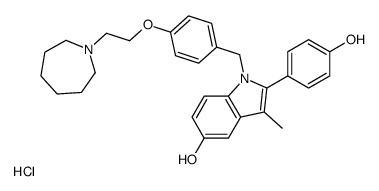Bazedoxifene hydrochloride
Modify Date: 2024-01-06 10:15:57

Bazedoxifene hydrochloride structure
|
Common Name | Bazedoxifene hydrochloride | ||
|---|---|---|---|---|
| CAS Number | 198480-56-7 | Molecular Weight | 507.06400 | |
| Density | N/A | Boiling Point | N/A | |
| Molecular Formula | C30H35ClN2O3 | Melting Point | N/A | |
| MSDS | N/A | Flash Point | N/A | |
Use of Bazedoxifene hydrochlorideBazedoxifene hydrochloride (TSE-424 hydrochloride) is an oral, BBB-penetrant nonsteroidal selective estrogen receptor modulator (SERM), with IC50s of 23 nM and 99 nM for ERα and ERβ, respectively. Bazedoxifene hydrochloride can be used for the research of osteoporosis. Bazedoxifene hydrochloride also acts as an inhibitor of IL-6/GP130 protein-protein interactions and can be used for the research of pancreatic cancer[1][2]. |
| Name | 1-[[4-[2-(azepan-1-yl)ethoxy]phenyl]methyl]-2-(4-hydroxyphenyl)-3-methylindol-5-ol,hydrochloride |
|---|---|
| Synonym | More Synonyms |
| Description | Bazedoxifene hydrochloride (TSE-424 hydrochloride) is an oral, BBB-penetrant nonsteroidal selective estrogen receptor modulator (SERM), with IC50s of 23 nM and 99 nM for ERα and ERβ, respectively. Bazedoxifene hydrochloride can be used for the research of osteoporosis. Bazedoxifene hydrochloride also acts as an inhibitor of IL-6/GP130 protein-protein interactions and can be used for the research of pancreatic cancer[1][2]. |
|---|---|
| Related Catalog | |
| Target |
IC50: 26 nM (ERα), 99 nM (ERβ)[1] |
| In Vitro | Bazedoxifene hydrochloride is a small molecular GP130 inhibitor, which binds to GP130 D1 domain[1]. Bazedoxifene hydrochloride inhibits STAT3 phosphorylation induced by Il-6 and IL-11 in GP130/STAT3 pathway signaling[1]. Bazedoxifene hydrochloride (10 μM-20 μM; 2 hours) inhibits STAT3 Phosphorylation Induced by cytokines in human pancreatic cancer cells[2]. Bazedoxifene hydrochloride (5-20 μM; overnight) induces apoptosis in human pancreatic cancer cells[2]. Bazedoxifene hydrochloride inhibits STAT3 nuclear translocation induced by IL-6[2]. Bazedoxifene hydrochloride blocks the cells migration in pancreatic cancer cells by inhibition of GP130[2]. Western Blot Analysis[2] Cell Line: AsPC-1 cells Concentration: 10 μM, 20 μM Incubation Time: 2 hours Result: Inhibited IL-6, IL-11 or OSM (50 ng/mL) induced STAT3 phosphorylation. Apoptosis Analysis[2] Cell Line: Capan-1 cells, BxPC-3 cells, HPAF-II cells, HPAC cells Concentration: 10 μM, 20 μM (Capan-1); 5 μM, 10 μM (BxPC-3); 10 μM, 20 μM (HPAF-II); 10 μM, 15 μM (HPAC) Incubation Time: Overnight Result: Induced apoptosis. |
| In Vivo | Bazedoxifene hydrochloride (5 mg/kg; i.g.; daily, for 18 days) inhibits Capan-1 tumor growth in mouse model in vivo[2]. Animal Model: 6-week-old female athymic nude mice[2] Dosage: 5 mg/kg Administration: Oral gavage, daily, for 18 days Result: Suppressed pancreatic cancer xenograft tumor growth and induced apoptosis in tumor cells. |
| References |
| Molecular Formula | C30H35ClN2O3 |
|---|---|
| Molecular Weight | 507.06400 |
| Exact Mass | 506.23400 |
| PSA | 57.86000 |
| LogP | 7.07090 |
| Storage condition | -20℃ |
| Bazedoxifene HCl |